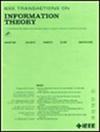量子局部可测试码的权衡结构
IF 2.2
3区 计算机科学
Q3 COMPUTER SCIENCE, INFORMATION SYSTEMS
引用次数: 0
摘要
在这项工作中,我们通过提出三种结构来继续寻找新参数的量子局部可测试码(qLTCs),这些结构可以从旧的qLTCs中生成新的qLTCs。首先分析了黑斯廷斯qLDPC码减重结构下量子码的稳健性,给出了qLTCs的减重过程。其次,我们描述了一种新的qLTC的“稳健性放大”过程,该过程可以将任何qLTC的稳健性增加到一个常数,同时保持其距离和维度,仅对其局域性产生影响。最后,我们首次将AEL距离放大结构应用于qLTC的情况,可以在牺牲其他参数的情况下将高距离的qLTC变为线性距离的qLTC。这些结构可以用于尚未发现的qLTCs以获得新的参数,但我们也发现了许多目前的应用,以证明在以前未知的参数体系中存在代码。特别地,这些运算在超球积码和半立方码上的应用产生了许多以前未知的参数。此外,还介绍了这三种结果在即将开展的工作中的应用。本文章由计算机程序翻译,如有差异,请以英文原文为准。
Tradeoff Constructions for Quantum Locally Testable Codes
In this work, we continue the search for quantum locally testable codes (qLTCs) of new parameters by presenting three constructions that can make new qLTCs from old. The first analyses the soundness of a quantum code under Hastings’ weight reduction construction for qLDPC codes to give a weight reduction procedure for qLTCs. Secondly, we describe a novel ‘soundness amplification’ procedure for qLTCs which can increase the soundness of any qLTC to a constant while preserving its distance and dimension, with an impact only felt on its locality. Finally, we apply the AEL distance amplification construction to the case of qLTCs for the first time which can turn a high-distance qLTC into one with linear distance, at the expense of other parameters. These constructions can be used on as-yet undiscovered qLTCs to obtain new parameters, but we also find a number of present applications to prove the existence of codes in previously unknown parameter regimes. In particular, applications of these operations to the hypersphere product code and the hemicubic code yield many previously unknown parameters. In addition, applications of all three results are described to an upcoming work.
求助全文
通过发布文献求助,成功后即可免费获取论文全文。
去求助
来源期刊

IEEE Transactions on Information Theory
工程技术-工程:电子与电气
CiteScore
5.70
自引率
20.00%
发文量
514
审稿时长
12 months
期刊介绍:
The IEEE Transactions on Information Theory is a journal that publishes theoretical and experimental papers concerned with the transmission, processing, and utilization of information. The boundaries of acceptable subject matter are intentionally not sharply delimited. Rather, it is hoped that as the focus of research activity changes, a flexible policy will permit this Transactions to follow suit. Current appropriate topics are best reflected by recent Tables of Contents; they are summarized in the titles of editorial areas that appear on the inside front cover.
 求助内容:
求助内容: 应助结果提醒方式:
应助结果提醒方式:


